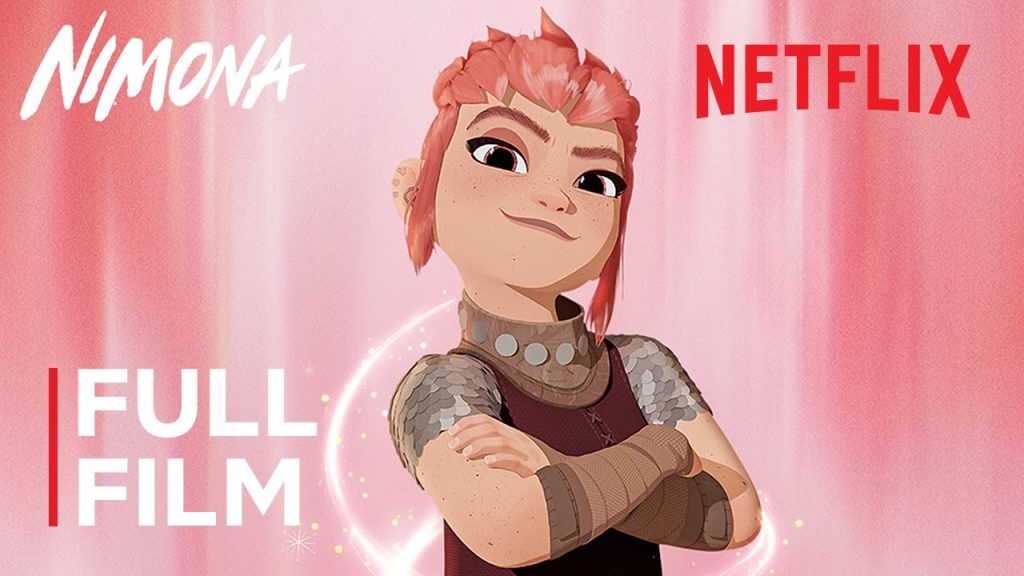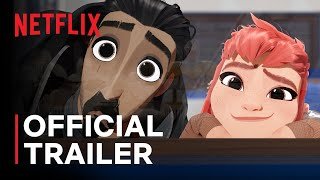Introduction: The Revolution Begins in the Shadows
Nimona is a film that defies categorization as easily as its titular character defies form. It’s science fiction. It’s fantasy. It’s a political allegory. It’s a story of grief, identity, rebellion, and transformation—all wrapped in the visual dynamism of animation and the emotional intensity of found-family narratives.
Set in a futuristic kingdom where high-tech and medieval traditions coexist, Nimona tells the story of Ballister Boldheart, a knight accused of a crime he didn’t commit, and Nimona, a teenage anarchist shapeshifter who insists on being his sidekick. Together, they upend the very foundations of a society built on rigid binaries: good vs. evil, knight vs. monster, tradition vs. chaos.
But Nimona is not just about narrative conflict. It’s about how stories are weaponized—how a culture’s need for safety often comes at the cost of truth, and how those who don’t fit the mold are turned into monsters simply for existing.
World-Building: A Society on the Edge of Its Myth
The film opens in a kingdom where knights protect the city under the rule of an elite institution known as The Institute. The world feels like a fusion of Arthurian legend and sci-fi futurism—a dystopia cloaked in ceremonial tradition and shimmering skyscrapers.
This world has one sacred narrative: monsters are evil, knights are good, and the Institute ensures peace through control. It is a society that confuses order with justice, and tradition with truth. Into this comes Ballister Boldheart—a commoner who becomes the first outsider knight, and Nimona—a shapeshifter, feared and hunted, whose mere existence challenges every myth the kingdom holds dear.
The architecture of the world reflects this tension. The clean lines of the city contrast sharply with the organic chaos of Nimona’s transformations. There is symmetry, but also suppression. Every rule seems to say: “Stay within your shape.” But Nimona exists to break form.
Character Deep Dive
1. Nimona: The Rebel Who Refuses to Stay One Thing
Nimona is not just a shapeshifter in the literal sense—she is a living metaphor for queerness, fluidity, and the fear society places on difference. Her transformations are visceral, beautiful, terrifying, and emotional. She becomes a gorilla, a bird, a shark, a flame—all manifestations of her emotional states.
She embodies joy and chaos simultaneously. She laughs in the face of danger but carries the trauma of rejection. Her shapeshifting is not just power—it’s a burden. It alienates her from others, forces her into solitude, and becomes the very reason society labels her a “monster.”
But the brilliance of her character lies in her refusal to conform. She never apologizes for what she is. She is loud, dramatic, affectionate, and unpredictable—but all of this is a defense mechanism against a world that treats her existence as a threat.
Nimona’s journey is about reclamation. She starts off seeking to be seen—by Ballister, by the world—but eventually realizes that she does not need approval. She needs truth. And she forces the world to confront its own lies.
2. Ballister Boldheart: The Knight Stripped of Armor
Ballister is the film’s emotional anchor. He is not the chosen hero—he is the one accused, discarded, and betrayed. He becomes a fugitive not because he failed, but because the system could not tolerate someone like him succeeding.
He is rational, moral, and deeply wounded. When he meets Nimona, he sees her first as a nuisance, then as a danger, and finally—as a mirror. Both are outcasts. Both have been labeled “wrong.” Where Nimona externalizes her rebellion, Ballister internalizes his shame.
His arc is about unlearning obedience. He must reject the black-and-white morality of the system he once served and accept the messy, transformative truth that justice requires breaking rules. Through Nimona, he learns that being a hero isn’t about upholding power—it’s about protecting the vulnerable.
Their relationship is not romantic. It is something deeper: two broken people who, through each other, begin to heal. Nimona doesn’t need saving—she needs believing. And Ballister learns that standing with her is the bravest act of all.
3. Ambrosius Goldenloin: Loyalty vs. Integrity
Ambrosius—Ballister’s former best friend and romantic partner—is a character torn between duty and conscience. He represents the insider—privileged, decorated, and trapped within the dogma of the Institute.
His conflict is subtle, but crucial. He wants to do good, but can’t see that the system he serves is built on fear. He hesitates, doubts, and eventually breaks—but his journey is slower than Ballister’s. He is not the villain—but he enables villainy through passivity.
His arc represents the cost of neutrality. Loving someone is not enough—one must choose them when it matters. His redemption lies not in speech, but in action—when he finally stands against the Institute and admits: “We were wrong.”
Themes:
1. Identity and Transformation
The central metaphor of Nimona is identity as fluid, changing, and expansive. The fear society has of Nimona is not rooted in what she does, but what she is. A creature that cannot be pinned down. A being who refuses to stay in one shape.
This echoes the fear of queerness, neurodivergence, or any form of existence that resists binaries. The Institute wants to erase such identity—not because it is dangerous, but because it defies control.
Nimona’s shapeshifting is not about spectacle—it’s about survival, and eventually, empowerment. Her final, monstrous transformation is not a descent into chaos—it’s a declaration: “You will see me, even if you are afraid.”
2. The Weaponization of Myth
The Institute rules not through violence, but through story. It frames itself as the protector, the monster-slayer, the moral compass. But its myths are lies—designed to maintain power.
It rewrites history. It punishes truth-tellers. It labels rebels as threats. It convinces even the knights that order is virtue, and questioning is treason.
The film dismantles this idea. It shows how institutions use fear to justify oppression. How they turn individuals into scapegoats. And how the real monsters are not the shapeshifters—but the storytellers who lie.
3. Found Family and Emotional Healing
At its core, Nimona is about two people who find in each other what the world denied them: acceptance. Nimona doesn’t want a father figure or a savior—she wants someone who won’t flinch when she reveals her true form.
Ballister, too, doesn’t want to lead a revolution—he wants to stop hiding who he is. Together, they form a bond not based on perfection, but on trust. They allow each other to be broken, to be angry, to be afraid.
Their connection is the emotional spine of the film. When Nimona vanishes in the climax, it feels like the death of possibility itself. But her return—after Ballister refuses to abandon her—is not just a victory. It is love, in its truest, most defiant form.
Visual Symbolism and Cinematic Language
Nimona uses color, movement, and form as narrative tools. The world is drawn with harsh lines and symmetry—suggesting rigidity. Nimona disrupts this with fluid animation. Her transformations are wild, colorful, and untamed.
When Nimona is happy, the screen bursts with motion. When she is threatened, the shadows grow longer. The Institute is always shown in static shots—tall, sterile, oppressive. Nimona is always in motion—curved lines, unpredictable angles.
The final battle—where she becomes a giant shadow beast—is not a descent into monstrosity, but a manifestation of pain. The animation becomes chaotic, cosmic, apocalyptic. Her body breaks the frame. The world finally sees her—and it is terrifying, not because she is evil, but because she is real.
And when she returns, in human form, arms wrapped around Ballister—it is not a moment of weakness, but of choice. She chooses to come back. Not for them. For him.
Conclusion: The Hero Isn’t Who You Think
Nimona is a film about stories—who gets to tell them, who gets erased, and who fights to be seen. It asks hard questions beneath its humor and style: What makes someone a monster? What if the thing we fear most is the truth? Can love exist in a world built on lies?
It answers with fire, laughter, and a girl who refuses to be less than all she is.
Nimona is not your typical hero. She doesn’t follow rules. She doesn’t speak softly. She is chaos with a conscience. But that is her power. And by the end, even the world must admit: she mattered.
In the end, Nimona is not about transformation—it is about acceptance. About loving what cannot be tamed. About standing beside the one everyone else runs from.
Because sometimes, the most radical thing you can say is: “I see you. And I’m still here.”

